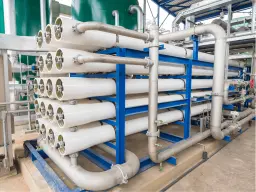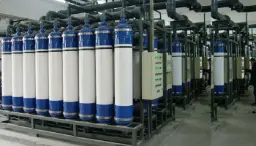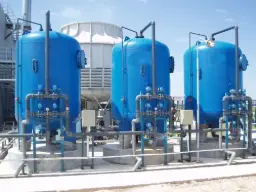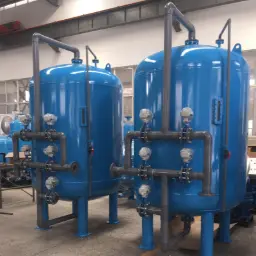Acid Mine Drainage Treatment
Acidic drainage flowing from exposed sulfide rock is one of the most persistent pollution legacies associated with hard-rock extraction. When pyrite and other sulfide minerals oxidise in the presence of water and oxygen they release ferrous iron, sulphate, and hydrogen ions, forming a low-pH leachate that aggressively dissolves additional metals from waste rock piles, tailings dams, and underground workings. In the mining and metallurgy sector, this phenomenon is known as acid mine drainage, and it can persist for decades, even after a site is closed. The resulting cocktail of acidity and dissolved aluminium, copper, zinc, cadmium, and arsenic threatens aquatic ecosystems, corrodes equipment, and inflates long-term remediation liabilities for mine operators. Effective treatment therefore sits at the intersection of environmental stewardship, regulatory compliance, and corporate risk management.
Acid mine drainage treatment is the engineered suite of physical, chemical, and biological operations that neutralise acid and selectively precipitate or adsorb heavy metals before the water is discharged or recycled on site. Unlike conventional municipal wastewater, AMD typically exhibits pH values below 4, ferric iron concentrations exceeding 100 mg L-1, and elevated dissolved solids that demand specialised process design. Whether the goal is to meet surface-water criteria, generate process-make-up water, or support zero-liquid-discharge strategies, an integrated treatment train must cope with high flow variability, extreme chemistry, and the remote settings common to many mining districts. As stakeholders increasingly judge projects by their social and environmental footprint, mastering AMD control has become a key differentiator for responsible producers of copper, gold, nickel, and rare-earth elements.
Water Treatment Systems Used
Acid mine drainage rarely surrenders to a single unit operation, so engineers combine technologies to exploit their complementary strengths. The selection depends on influent composition, target limits, reagent availability, and whole-of-life economics, yet several core systems appear repeatedly across successful plants. The paragraphs below introduce the toolkit, setting the stage for the detailed list that follows. They compare high-density sludge processes with conventional lime clarification, explore passive bioreactors for remote sites, and highlight how membrane barriers polish residual ions. Attention is also given to reagent-free electrocoagulation and to modern sulphide precipitation units that recover saleable metal by-products. By examining these alternatives through the lens of mining logistics, power constraints, and discharge permits, designers can tailor robust treatment trains that retain flexibility as mine plans evolve. Importantly, digital twin modelling and cloud-based supervisory control now enable rapid sensitivity testing of process changes, reducing commissioning surprises and shortening ramp-up curves.

Reverse Osmosis
Combines nanofiltration to reject polyvalent metals and sulphate with reverse osmosis to trim total dissolved solids, delivering permeate suitable for boiler makeup or underground dust suppression.

High-Density Sludge (HDS) Lime Treatment
Continuously recycles a portion of settled solids to seed rapid crystal growth, achieving slurry densities above 30 % and improving dewatering while using 20-30 % less lime than conventional clarifiers.

Anaerobic Sulphate-Reducing Bioreactor (SRB)
Utilises sulphate-reducing bacteria immobilised on organic media to convert sulphate to sulphide, generating alkalinity and precipitating metals as insoluble sulphides without chemical reagents.

Ion Exchange Systems
Employs chelating resins with high selectivity for Cu, Ni, and Co at near-neutral pH, enabling metal recovery and effluent polishing down to sub-ppm levels before surface discharge.
These systems are critical because they collectively tackle acidity, dissolved metals, sulphate, and total salinity - the four signature contaminants of acid mine drainage. An HDS circuit guarantees stable primary neutralisation and cost-efficient sludge handling. When space or reagent logistics dictate low-touch solutions, anaerobic bioreactors extend coverage without constant operator presence. Ion exchange and membrane barriers provide the fine polishing increasingly demanded by downstream water-reuse strategies or strict river-basin standards. Together, they yield a treatment train that meets present discharge limits yet can be upgraded if the mine expands or closure objectives tighten, supporting adaptive water stewardship in dynamic mining environments.
Key Water-Quality Parameters Monitored
A sophisticated acid mine drainage facility depends on rigorous monitoring to keep chemistry within design envelopes, optimise reagent dosing, and document compliance for regulators. Engineers track both macro parameters such as pH, oxidation-reduction potential, and electrical conductivity, and micro indicators including individual metal species and dissolved oxygen. Real-time sensors linked via industrial IoT platforms stream data to cloud analytics, where predictive algorithms flag up-coming excursions, allowing proactive chemical adjustments that cut lime consumption and sludge volumes. Because AMD chemistry can shift abruptly during heavy rainfall or when a new ore lens is exposed, automated sampling stations are positioned at critical control points: influent, post-neutralisation, post-clarification, and final discharge. Long-term data archives further support audits of water balances, helping mine planners justify reduced freshwater intake and demonstrating social licence achievements to investors.
Beyond routine compliance, parameter tracking informs asset management: scaling indices warn operators before thick scaling chokes pipelines, while rising redox potential may signal aeration blower failure in an SRB cell. Many plants now integrate carbon-footprint dashboards by correlating reagent use, pump energy, and sludge trucking mileage with kilogrammes of CO₂ equivalent, driving continuous improvement under corporate ESG goals. Table 1 summarises the parameters most frequently measured, their typical ranges in untreated AMD, and the preferred control methods that appear in modern flowsheets.
| Parameter | Typical Untreated Range | Control Method |
|---|---|---|
| pH | 2.0 – 4.5 | Lime or caustic dosing, automated feedback control |
| Total Iron (mg L-1) | 50 – 2 000 | Aeration plus lime precipitation or HDS circuit |
| Sulphate (mg L-1) | 1 000 – 8 000 | Bioreactor reduction, nanofiltration, or barium precipitation |
| Dissolved Aluminium (mg L-1) | 10 – 500 | Lime softening, microfiltration, or ion exchange |
| Electrical Conductivity (µS cm-1) | 2 000 – 15 000 | Reverse osmosis polishing or blending with clean water |
Table 1 – Critical parameters in acid mine drainage treatment and typical control strategies.
Design & Implementation Considerations
Translating process fundamentals into a reliable plant begins with a mine-wide water balance that captures seasonal precipitation, evaporation, underground inflow, and process-water recycle loops. Engineers test representative samples across wet and dry seasons, then pilot candidate technologies at bench and container scale to confirm reagent doses, sludge settling rates, and membrane flux under site-specific conditions. Geotechnical assessments influence concrete chemistry, as highly aggressive acidic solutions can degrade ordinary Portland cement; many designers specify sulphate-resistant mixes or polymer linings. Climate also dictates equipment choices: in alpine regions, lime silos require heat tracing and enclosed unloading hoppers to prevent bridging; in arid deserts, dust-control sprays and solar-powered telemetry offer resilience where grid power is scarce.
Constructability considerations often dominate capital-cost estimates. Remote sites may prefer modular skid-mounted clarifiers shipped in ISO containers, allowing assembly with minimal crane time. When tailings dams provide convenient sludge deposition ponds, designers can downsize mechanical thickeners, but need contingency storage if extreme rainfall renders ponds unusable. Instrumentation architecture must align with the mine’s digital roadmap; plants leveraging plant-wide DCS platforms can justify advanced model-predictive control that reduces lime usage by 5-10 %. Conversely, standalone treatment sheds might rely on PLCs with cellular backhaul. Finally, life-cycle costing should weigh reagent pricing scenarios, sludge hauling distance to licenced landfills, and the potential revenue from recovering saleable copper sulphide cake, an increasingly attractive offset where grade and scale permit.
Operation & Maintenance
Once commissioned, day-to-day operation centres on human-machine interface screens that plot pH, turbidity, and sludge underflow density in real time. Operators adjust lime slurry concentration to stabilise the thickener underflow density between 30 % and 35 %, ensuring consistent seed recycle while minimising blinding of downstream filter presses. Preventive maintenance routines include weekly calibration of pH electrodes, monthly greasing of rakes and agitators, and quarterly wear-plate inspections on slurry pumps subject to erosive iron hydroxide. Reagent delivery logistics demand forecasting tools that account for haul-road closures during winter or monsoon seasons, as stock-outs can trigger compliance breaches and costly stand-downs.
Sludge management forms the bulk of OPEX. Dewatering performance hinges on polymer selection, which itself varies with influent mineralogy; continuous jar testing optimises dosing curves and can reduce polymer consumption by 15 %. Remote sensing drones increasingly monitor containment embankments for early signs of seepage, integrating with SCADA alarms. Worker safety remains paramount: confined-space gas monitors detect hydrogen sulphide in SRB headspaces, while lime-handling PPE and dust extraction minimise respiratory exposure. Digital maintenance platforms schedule tasks based on runtime hours and trend analysis instead of fixed calendars, extending bearing life and reducing unscheduled downtime. Over time, data-driven optimisation often halves sludge disposal tonnage by enabling higher solids capture or beneficial reuse, such as cement-kiln feedstock, aligning O&M with circular-economy ambitions.
Challenges & Solutions
Acid mine drainage projects confront a spectrum of hurdles, from fluctuating influent chemistry and remote geography to evolving legal standards that ratchet down permissible metal loads. Sudden pH drops can redissolve previously precipitated metals, leading to permit violations; installing redundant pH probes and rapid-mix reaction tanks buffers such shocks. Scaling and fouling of membrane elements threaten reliability; anti-scalant dosing, periodic citric-acid cleaning, and designing for lower recovery ratios preserve flux while extending membrane life. Long-term sludge stability is another concern: under reducing conditions, previously immobilised metals can remobilise. Stabilisation with pozzolanic additives or encapsulation in geopolymer matrices reduces leachability and unlocks potential revenue streams from construction-material markets.
Power availability and cost pose additional constraints for off-grid sites. Hybridising treatment with solar arrays and battery storage mitigates diesel reliance; variable-speed drives on pumps and blowers slash energy intensity by up to 25 %. Climate resilience must also be factored: in permafrost regions, heat-trace loops and insulated pipe corridors prevent freeze-ups, whereas tropical installations require corrosion-resistant alloys to resist aggressive condensates. Finally, community expectations around water use and discharge transparency drive adoption of online dashboards that publish live water-quality data, fostering trust and defusing potential social-licence conflicts. By approaching challenges holistically—combining engineering controls, adaptive management, and stakeholder engagement—operators turn a compliance burden into a showcase of responsible mining.
Advantages & Disadvantages
Before weighing equipment bids or screening reagent options, decision-makers need a balanced view of acid mine drainage treatment’s benefits and trade-offs. Introducing a dedicated treatment plant demonstrably improves downstream ecology, reducing fish mortality and ensuring potable supplies for nearby communities. It also unlocks water reuse within the concentrator, lowering freshwater abstraction and associated pumping energy. Regulatory compliance shields companies from fines and production stoppages, while recovered metals can generate supplemental revenue. On the downside, capital expenditure is significant, particularly for membrane polishing or complex bioreactors. Ongoing lime, soda ash, and polymer consumption adds operational overhead, and sludge management may necessitate costly transport to off-site hazardous-waste facilities. Positioning these pros and cons within a structured evaluation framework helps mining executives justify the investment and align it with corporate sustainability goals.
| Advantages | Disadvantages |
|---|---|
| Achieves strict discharge limits for acidity, metals, and sulphate | High capital cost for bespoke clarifiers, reactors, and dewatering |
| Enables reuse of treated water, reducing freshwater intake and pumping energy | Continuous reagent consumption (lime, polymers, anti-scalants) |
| Demonstrates corporate commitment to ESG and community health | Sludge requires disposal or further stabilisation |
| Potential recovery of valuable metals via sulphide precipitation or ion exchange | Complex automation and monitoring systems demand skilled staff |
| Reduces long-term closure liabilities and improves asset valuations | Remote locations may face challenging logistics for reagent supply |
Table 2 – Key benefits and limitations of dedicated AMD treatment plants.
Frequently Asked Questions
Understanding acid mine drainage treatment often involves clarifying recurring queries from engineers, regulators, and community stakeholders. The paragraphs below address the most common concerns, drawing on best practice and field experience to demystify design choices and practical outcomes. By pre-empting these questions, project teams accelerate stakeholder buy-in and streamline permitting timelines. They also create an enduring knowledge base that reduces operator error and enhances cross-functional collaboration between process engineers, environmental scientists, and maintenance crews. The answers emphasise evidence-backed performance metrics, regulatory trends, and emerging innovations such as artificial-intelligence-assisted chemical dosing.
- What pH should be targeted after primary neutralisation? Most regulators accept a discharge range of 6.5-9.0, but many plants aim for a tighter band of 7.0-8.0 to maximise metal precipitation while limiting excess lime consumption.
- Can passive wetlands replace active treatment systems? For low-flow sites, engineered wetlands can polish effluent cost-effectively, yet they rarely handle the high acid loads seen at active open-pit mines without supplemental alkalinity.
- How is sludge volume reduced? High-density sludge recycling, polymer optimisation, and plate-and-frame filter presses can cut disposal volumes by 60 % relative to conventional lime clarification.
- Is metal recovery economically viable? When influent copper exceeds 100 mg L-1 or zinc tops 200 mg L-1, sulphide precipitation followed by flotation can yield concentrates with payback periods under three years.
- Do membranes foul quickly on AMD? Proper pre-treatment (iron removal, pH adjustment) and anti-scalant dosing allow nanofiltration or RO membranes to operate with 80-85 % recovery and cleaning intervals of 30-45 days, comparable to seawater desalination plants.
- What automation level is recommended? Mines integrating treatment into the main DCS gain predictive-control advantages and centralised alarms, while smaller sites can operate effectively with PLCs and cellular telemetry if redundancy is built in.